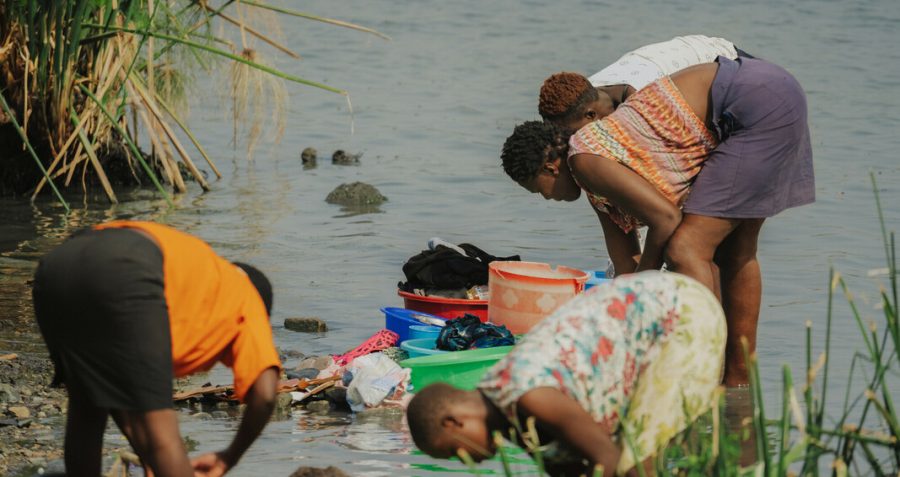
Written by Frontline AIDS
Can female genital schistosomiasis (FGS) services be implemented as part of broader sexual and reproductive health and rights (SRHR) interventions? Are healthcare workers and women and girls receptive to these changes? If so, what is needed to make it happen and what is the best way to share these lessons from Kenya?
These were some of the guiding questions for the FGS Integration Project, that LVCT Health implemented in collaboration with Frontline AIDS, and Bridges to Development in three counties of Kenya, from 2023 to 2025.
The project showed that integrating FGS into sexual and reproductive health and rights interventions (SRHR) isn’t just ‘possible’, but that it is vital to reach women and girls with this unknown condition.
FGS IS OFTEN UNKNOWN AND MISDIAGNOSED
FGS is a serious gynaecological condition caused by a water-borne parasite called schistosomiasis haematobium or bilharzia. It disproportionately affects women and girls who lack access to safe, clean water, sanitation and quality healthcare. The condition causes inflammation and lesions in the genital tissue that, if left untreated, can lead to infertility and increase the risk of HIV, Human Papilloma Virus (HPV) and cervical cancer. It is often misdiagnosed and misunderstood, as well as under-reported and under-researched.
Healthcare workers are largely unaware of FGS, as this is generally not covered in their medical training curricula. As FGS is relatively unknown and has similar symptoms to Sexually Transmitted Infections (STIs), many women are often misdiagnosed with an STI, instead of with FGS. This misdiagnosis can result in incorrect treatment, stigma, discrimination and gender-based violence (GBV).
“Previously, there used to be a lot of quarrels in the family… A man wants to have sex, but the wife says she is having pain, so the husband will say that it is an STI because people believed that everything is STI,” said one woman from Homa Bay, who was part of the project.
The project set out to examine how FGS services can be integrated into SRHR interventions, budgets and policies – nationally within Kenya, and locally in the Homa Bay, Kwale and Kilifi counties, which all have a high prevalence of schistosomiasis.
The project sought to create awareness about FGS in communities and healthcare facilities and to ensure that healthcare workers were able to diagnose and treat FGS as well as support women experiencing stigma, discrimination and GBV.
IS INTEGRATING FGS INTO SRHR SERVICES POSSIBLE?
The project defined and piloted a ‘minimum service package’ (MSP) for FGS-SRHR integration and then assessed the ‘feasibility, acceptability, and cost’ of this integration.
The MSP demonstrated how the health literacy, screening, diagnosis and treatment of FGS could be integrated into routine health screenings – as well as support women with mental health.
Importantly, healthcare workers from Homa Bay said that they felt that this approach was feasible and didn’t significantly add to their workload: “In the process of screening cancer, you are also screening for FGS, so there is no workload at all. It is not adding anything, because as you write the report of cancer screening, you also write the FGS report”.
The integration of health areas is particularly important now given that global health funding and strategies are increasingly moving away from siloed approaches that focus on one health issue. Crucially, this approach also benefits the women receiving integrated healthcare, who do not have the time or resources for multiple trips to different clinics.
Findings from the integration pilot in Kenya demonstrated that women and girls were receptive to receiving integrated FGS and SRHR interventions and that healthcare workers were happy to provide them.
“We are doing a one-stop shop,” said a female health worker from Kwale County. “When we see the client, we sell all the services. So nowadays there’s nothing that needs to be changed. It’s a routine. They know we offer all the services.”
However, the project findings demonstrated that integrating FGS into SRHR services is only feasible if clinical staff receive training and supportive supervision, diagnostic supplies are available, and facilities are adequately stocked with praziquantel – the medication used to treat FGS.
Funded by the Children’s Investment Fund Foundation (CIFF), the project resulted in:
- 400 healthcare workers and 345 community health workers being trained on FGS integration.
- 8,856 women being screened for FGS, of which 27% (2,441 women) were diagnosed with FGS and were treated with praziquantel, at a cost of $10.30 per woman.*
- Nearly 56,000 women reached with FGS health literacy, at a cost of just $0.50 per woman.*
*These costs are considered low in comparison to other studies on integrated SRHR services.
SCALING UP THE APPROACH TO REACH MORE WOMEN
Given these promising findings, this approach has the potential to be adopted in other schistosomiasis endemic areas to meet the needs of the millions of girls and women affected by this neglected condition.
Sustaining – and ultimately scaling up – this integrated approach requires action at national and global levels.
Globally, funding needs to be made available for integrated health approaches that can support more FGS pilot projects. FGS, although caused by a neglected tropical disease, must be recognised as a SRH condition and referenced in SRH policies and strategies. Normative guidelines must urgently be developed across the pillars of the health system. Training curricula for healthcare workers must also be developed, including integration with sectors related to stigma, discrimination and GBV. FGS must be recognised as a gendered issue and integrated into policies to support gender equality.
In parallel, guidelines must be developed to support the integration of FGS into national health systems, and indicators must be developed and added into data systems to record cases. Treatment must be available in healthcare facilities, and training curricula must embedded into healthcare worker training.
A core finding of the study was the importance of health literacy and raising awareness about FGS so that communities are aware of this neglected condition and know that they can seek and receive help. Strong political leadership at the national and local level, specifically in local level health planning, is crucial so that women living with FGS are no longer neglected and can get the support and treatment that they need.
“Each and every time I meet new people, the same conversation comes up,” said a woman treated for FGS and interviewed for our short film. “I want them to know about FGS. My hope is I want them to be FGS free.”
Learn more about the women affected by FGS by watching our short film, FGS: The Silent Women’s Epidemic
